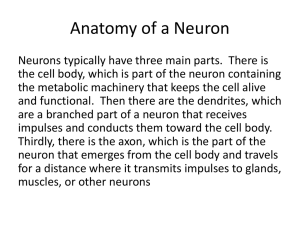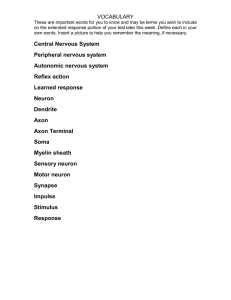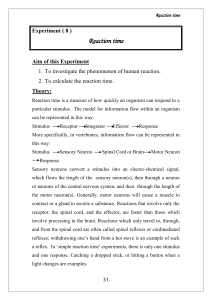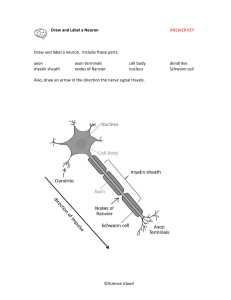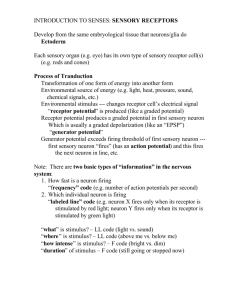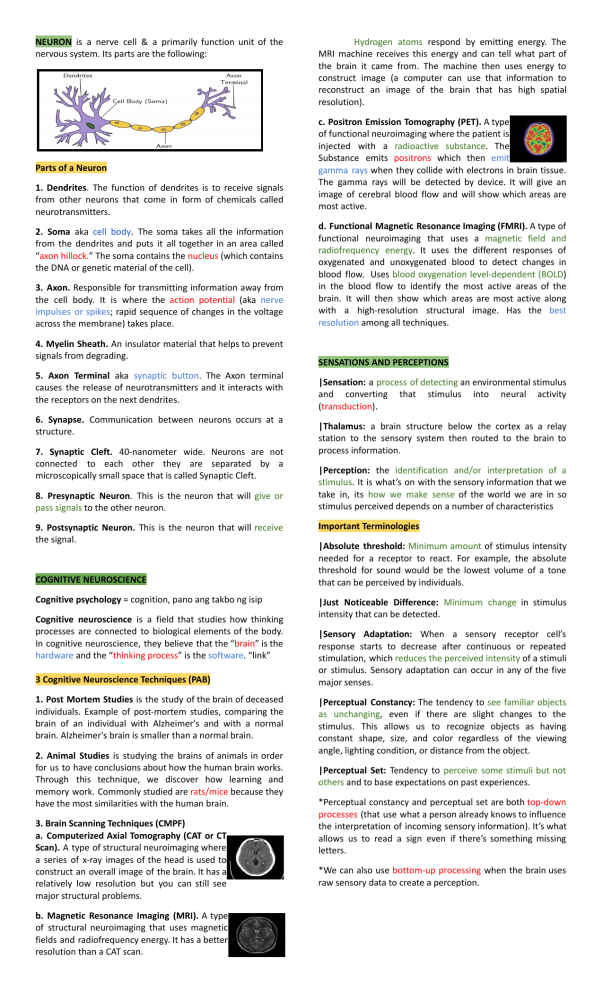
NEURON is a nerve cell & a primarily function unit of the nervous system. Its parts are the following: Parts of a Neuron 1. Dendrites. The function of dendrites is to receive signals from other neurons that come in form of chemicals called neurotransmitters. 2. Soma aka cell body. The soma takes all the information from the dendrites and puts it all together in an area called “axon hillock.” The soma contains the nucleus (which contains the DNA or genetic material of the cell). 3. Axon. Responsible for transmitting information away from the cell body. It is where the action potential (aka nerve impulses or spikes; rapid sequence of changes in the voltage across the membrane) takes place. 4. Myelin Sheath. An insulator material that helps to prevent signals from degrading. 5. Axon Terminal aka synaptic button. The Axon terminal causes the release of neurotransmitters and it interacts with the receptors on the next dendrites. 6. Synapse. Communication between neurons occurs at a structure. 7. Synaptic Cleft. 40-nanometer wide. Neurons are not connected to each other they are separated by a microscopically small space that is called Synaptic Cleft. 8. Presynaptic Neuron. This is the neuron that will give or pass signals to the other neuron. 9. Postsynaptic Neuron. This is the neuron that will receive the signal. COGNITIVE NEUROSCIENCE Cognitive psychology = cognition, pano ang takbo ng isip Cognitive neuroscience is a field that studies how thinking processes are connected to biological elements of the body. In cognitive neuroscience, they believe that the “brain” is the hardware and the “thinking process” is the software. “link” 3 Cognitive Neuroscience Techniques (PAB) 1. Post Mortem Studies is the study of the brain of deceased individuals. Example of post-mortem studies, comparing the brain of an individual with Alzheimer's and with a normal brain. Alzheimer's brain is smaller than a normal brain. 2. Animal Studies is studying the brains of animals in order for us to have conclusions about how the human brain works. Through this technique, we discover how learning and memory work. Commonly studied are rats/mice because they have the most similarities with the human brain. 3. Brain Scanning Techniques (CMPF) a. Computerized Axial Tomography (CAT or CT Scan). A type of structural neuroimaging where a series of x-ray images of the head is used to construct an overall image of the brain. It has a relatively low resolution but you can still see major structural problems. b. Magnetic Resonance Imaging (MRI). A type of structural neuroimaging that uses magnetic fields and radiofrequency energy. It has a better resolution than a CAT scan. Hydrogen atoms respond by emitting energy. The MRI machine receives this energy and can tell what part of the brain it came from. The machine then uses energy to construct image (a computer can use that information to reconstruct an image of the brain that has high spatial resolution). c. Positron Emission Tomography (PET). A type of functional neuroimaging where the patient is injected with a radioactive substance. The Substance emits positrons which then emit gamma rays when they collide with electrons in brain tissue. The gamma rays will be detected by device. It will give an image of cerebral blood flow and will show which areas are most active. d. Functional Magnetic Resonance Imaging (FMRI). A type of functional neuroimaging that uses a magnetic field and radiofrequency energy. It uses the different responses of oxygenated and unoxygenated blood to detect changes in blood flow. Uses blood oxygenation level-dependent (BOLD) in the blood flow to identify the most active areas of the brain. It will then show which areas are most active along with a high-resolution structural image. Has the best resolution among all techniques. SENSATIONS AND PERCEPTIONS |Sensation: a process of detecting an environmental stimulus and converting that stimulus into neural activity (transduction). |Thalamus: a brain structure below the cortex as a relay station to the sensory system then routed to the brain to process information. |Perception: the identification and/or interpretation of a stimulus. It is what’s on with the sensory information that we take in, its how we make sense of the world we are in so stimulus perceived depends on a number of characteristics Important Terminologies |Absolute threshold: Minimum amount of stimulus intensity needed for a receptor to react. For example, the absolute threshold for sound would be the lowest volume of a tone that can be perceived by individuals. |Just Noticeable Difference: Minimum change in stimulus intensity that can be detected. |Sensory Adaptation: When a sensory receptor cell’s response starts to decrease after continuous or repeated stimulation, which reduces the perceived intensity of a stimuli or stimulus. Sensory adaptation can occur in any of the five major senses. |Perceptual Constancy: The tendency to see familiar objects as unchanging, even if there are slight changes to the stimulus. This allows us to recognize objects as having constant shape, size, and color regardless of the viewing angle, lighting condition, or distance from the object. |Perceptual Set: Tendency to perceive some stimuli but not others and to base expectations on past experiences. *Perceptual constancy and perceptual set are both top-down processes (that use what a person already knows to influence the interpretation of incoming sensory information). It’s what allows us to read a sign even if there’s something missing letters. *We can also use bottom-up processing when the brain uses raw sensory data to create a perception.
